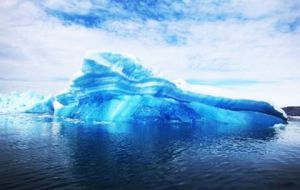MercoPress. South Atlantic News Agency
Record high temperatures over land and sea in March, says NOAA and NASA
 March average temperature across global land and ocean surfaces was 0.85°C above the 20th century average, the highest for March in the 1880–2015 record
March average temperature across global land and ocean surfaces was 0.85°C above the 20th century average, the highest for March in the 1880–2015 record The globally averaged temperature over land and ocean surfaces for March 2015 was the highest for the month since record keeping began in 1880. The year-to-date (January–March) globally averaged temperature was also record high, reports the US National Oceanographic and Atmospheric Administration, together with data from NASA.
During March, the average temperature across global land and ocean surfaces was 1.53°F (0.85°C) above the 20th century average. This was the highest for March in the 1880–2015 record, surpassing the previous record of 2010 by 0.09°F (0.05°C).
During March, the globally-averaged land surface temperature was 2.97°F (1.65°C) above the 20th century average. This tied with 1990 as the second highest for March in the 1880–2015 record.
During March, the globally-averaged sea surface temperature was 0.99°F (0.55°C) above the 20th century average. This was the third highest for March in the 1880–2015 record.
The average Arctic sea ice extent for March was 430,000 square miles (7.2 percent) below the 1981–2010 average. This was the smallest March extent since records began in 1979, according to analysis by the National Snow and Ice Data Center based on data from NOAA and NASA.
Antarctic sea ice during March was 420,000 square miles (24.3 percent) above the 1981–2010 average. This was the second largest March Antarctic sea ice extent on record. The record largest March Antarctic sea ice extent occurred in 2008 and was 100,000 square miles larger than the March 2015 extent.
According to data from NOAA analyzed by the Rutgers Global Snow Lab, the Northern Hemisphere snow cover extent during March was 640,000 square miles below the 1981–2010 average. This was the seventh smallest March Northern Hemisphere snow cover extent in the 49-year period of record. Eurasia had its ninth smallest March snow cover extent, while North America had its 10th smallest.
As to the first quarter of the year, the average temperature across global land and ocean surfaces was 1.48°F (0.82°C) above the 20th century average. This was the highest for January–March in the 1880–2015 record, surpassing the previous record of 2002 by 0.09°F (0.05°C).
During January–March, the globally-averaged land surface temperature was 2.86°F (1.59°C) above the 20th century average. This was the highest for January–March in the 1880–2015 record, surpassing the previous record of 2002 by 0.09°F (0.05°C).
During January–March, the globally-averaged sea surface temperature was 0.95°F (0.53°C) above the 20th century average. This was the third highest for January–March in the 1880–2015 record.





Top Comments
Disclaimer & comment rules-

-

Read all commentsWhenever you see the dark red bits, CFK has been visiting,
Apr 23rd, 2015 - 11:46 am 0if she only stopped gassing and crying , perhaps there would be more white or purple.
NASA climate change / global warming statistics.
Apr 23rd, 2015 - 06:06 pm 0I hate this nonsense, it gives statistics a bad name.
When NASA can operate correctly, without fudging the data and deliberately lying I will listen to them.
Commenting for this story is now closed.
If you have a Facebook account, become a fan and comment on our Facebook Page!